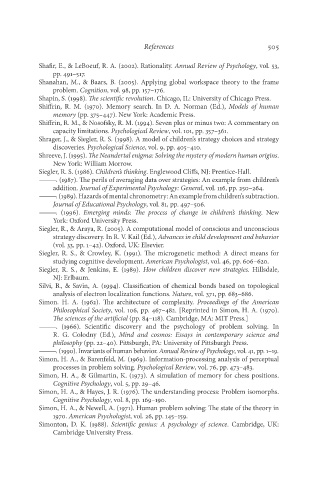Page 522 - Deep Learning
P. 522
References 505
Shafir, E., & LeBoeuf, R. A. (2002). Rationality. Annual Review of Psychology, vol. 53,
pp. 491–517.
Shanahan, M., & Baars, B. (2005). Applying global workspace theory to the frame
problem. Cognition, vol. 98, pp. 157–176.
Shapin, S. (1998). The scientific revolution. Chicago, IL: University of Chicago Press.
Shiffrin, R. M. (1970). Memory search. In D. A. Norman (Ed.), Models of human
memory (pp. 375–447). New York: Academic Press.
Shiffrin, R. M., & Nosofsky, R. M. (1994). Seven plus or minus two: A commentary on
capacity limitations. Psychological Review, vol. 101, pp. 357–361.
Shrager, J., & Siegler, R. S. (1998). A model of children’s strategy choices and strategy
discoveries. Psychological Science, vol. 9, pp. 405–410.
Shreeve, J. (1995). The Neandertal enigma: Solving the mystery of modern human origins.
New York: William Morrow.
Siegler, R. S. (1986). Children’s thinking. Englewood Cliffs, NJ: Prentice-Hall.
———. (1987). The perils of averaging data over strategies: An example from children’s
addition. Journal of Experimental Psychology: General, vol. 116, pp. 250–264.
———. (1989). Hazards of mental chronometry: An example from children’s subtraction.
Journal of Educational Psychology, vol. 81, pp. 497–506.
———. (1996). Emerging minds: The process of change in children’s thinking. New
York: Oxford University Press.
Siegler, R., & Araya, R. (2005). A computational model of conscious and unconscious
strategy discovery. In R. V. Kail (Ed.), Advances in child development and behavior
(vol. 33, pp. 1–42). Oxford, UK: Elsevier.
Siegler, R. S., & Crowley, K. (1991). The microgenetic method: A direct means for
studying cognitive development. American Psychologist, vol. 46, pp. 606–620.
Siegler, R. S., & Jenkins, E. (1989). How children discover new strategies. Hillsdale,
NJ: Erlbaum.
Silvi, B., & Savin, A. (1994). Classification of chemical bonds based on topological
analysis of electron localization functions. Nature, vol. 371, pp. 683–686.
Simon. H. A. (1962). The architecture of complexity. Proceedings of the American
Philosophical Society, vol. 106, pp. 467–482. [Reprinted in Simon, H. A. (1970).
The sciences of the artificial (pp. 84–118). Cambridge, MA: MIT Press.]
———. (1966). Scientific discovery and the psychology of problem solving. In
R. G. Colodny (Ed.), Mind and cosmos: Essays in contemporary science and
philosophy (pp. 22–40). Pittsburgh, PA: University of Pittsburgh Press.
———. (1990). Invariants of human behavior. Annual Review of Psychology, vol. 41, pp. 1–19.
Simon, H. A., & Barenfeld, M. (1969). Information-processing analysis of perceptual
processes in problem solving. Psychological Review, vol. 76, pp. 473–483.
Simon, H. A., & Gilmartin, K. (1973). A simulation of memory for chess positions.
Cognitive Psychology, vol. 5, pp. 29–46.
Simon, H. A., & Hayes, J. R. (1976). The understanding process: Problem isomorphs.
Cognitive Psychology, vol. 8, pp. 169–190.
Simon, H. A., & Newell, A. (1971). Human problem solving: The state of the theory in
1970. American Psychologist, vol. 26, pp. 145–159.
Simonton, D. K. (1988). Scientific genius: A psychology of science. Cambridge, UK:
Cambridge University Press.

